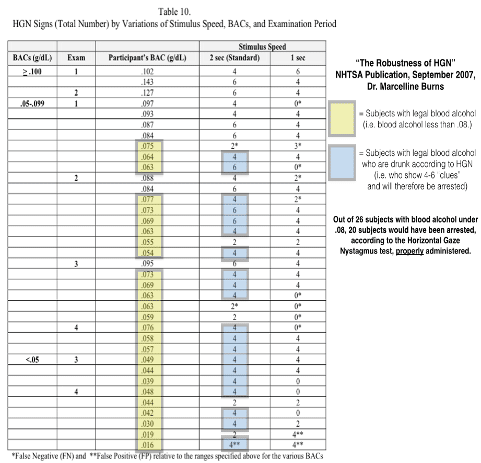The horizontal gaze nystagmus test is infamous. You know the one — the police officer shines a light in your eyes and asks you to follow it. If you’re pulled over under suspicion of DWI in Texas, you’ll be expected to participate in one or more of these sobriety tests. In our opinion, the side of the road isn’t exactly a perfect place to conduct these experiments with such small margins for error, especially when your freedom is on the line.
Although there is no such thing as an “easy” standardized field sobriety test in Texas, there are lawyers that can come to your defense. If you or a loved one performed poorly on the horizontal gaze nystagmus, one-leg stand, or walk-and-turn test and are now facing a charge for DWI, call Thiessen Law Firm at (713) 864-9000 for aggressive and skilled representation today.
How does the horizontal gaze nystagmus test work?
When you’re pulled over under suspicion of DWI there is no telling which field sobriety tests the police will choose to administer, but the horizontal gaze nystagmus is a popular one.
How does it work?
Below are the horizontal gaze nystagmus steps for test administration given by the National Highway Traffic Safety Administration (NHTSA). For the purposes of these instructions, nystagmus is defined as “an involuntary rhythmic side-to-side, up and down, or circular motion of the eyes.”
- Ask that the suspect remove any glasses or hard contacts, check that their pupil sizes are equal and the eyes track equally then establish a baseline for natural resting nystagmus.
- Instruct the suspect to keep their head still and follow the stimulus. Instruct the suspect not to move their eyes back to the center position until instructed.
- If the suspect moves their head, use a flashlight or your free hand as a chinrest. Position the stimulus 12-15 inches away from their face, slightly above their eye level.
- Check the client’s left eye first by moving the stimulus to their right. Have the suspect follow the stimulus until their eye cannot move further to the side. The motion should take about two seconds from nose out and 2 seconds back in.
- Observe whether the suspect could follow the object smoothly or if the motion was start-and-stop or jerky.
- Repeat the same movements for the client’s right eye.
- Check each eye twice for Lack of Smooth Pursuit.
- Next, check the client’s left eye first and take the stimulus all the way out until you can see no more white in the corner of their eyes. This will be maximum deviation. Hold the stimulus out there for at least 4 seconds to see if the eyes jerk continually while at maximum deviation.
- It should take 2 seconds from nose to maximum deviation. Hold for at least 4 seconds, then back in at 2 seconds from maximum deviation to the nose.
- Repeat the same timing and procedure for the client’s right eye.
- Check each eye twice for distinct and sustained nystagmus and maximum deviation.
- For the third clue, start by checking the client’s left eye first again. Take the stimulus at a slow rate until you hit 45 degrees. You can measure that at about the end of their shoulder. The rate should be about 1 second for each 10 degrees lasting for about 4 seconds. If you see a jerk before 45 degrees, you should stop.
- Observe for any jerking motion in the suspect’s eye. If you see evident nystagmus, stop moving the stimulus and observe whether the jerking continues.
- If the nystagmus continues, this is the angle of onset. If it does not continue, continue moving the stimulus until you reach the 45-degree angle.
- Use the same rate of speed and procedure to check the client’s right eye.
- Check each eye twice for nystagmus prior to 45 degrees.
Now that is a hell of a booklet. It certainly seems well-thought-out, well-researched, and difficult to execute correctly for the average police officer. Right? Not exactly, but more on that later. First, let’s go through the clues that can cause you to fail and land you in the back of a police cruiser.
What are the 6 clues of the HGN test?
There are three clues per eye that police officers use to assign intoxication. You receive one point for each clue found in either eye, with a total possible score of six points. If you total four points, you are considered intoxicated and will likely be arrested. The clues are as follows:
- Clues 1 and 2 are the lack of smooth pursuit in the right and/or left eye.
- Clues 3 and 4 are distinct and sustained nystagmus at maximum deviation in the right and/or left eye.
- Clues 5 and 6 are onset of nystagmus prior to 45 degrees in the left and/or right eye..
These clues are liberally observed and can be triggered by a number of things other than intoxication. The suspect is essentially set up to fail. To even the playing field, you’re going to need a good lawyer, one who knows the science behind why these tests are unfair.
Mark Thiessen from Thiessen Law Firm is an ACS-CHAL Lawyer-Scientist, which means he is uniquely qualified to ensure any bogus science isn’t used against his clients in the courtroom.
Continue reading: Can you refuse a field sobriety test?
3 (of the many) horizontal gaze nystagmus test problems
The big problem with the HGN test, and all sobriety tests, is that they are extremely flawed from a scientific perspective. Here are just a few problems with this specific test:
- Eyes are incredibly subjective, and there is little to no room for variance built into the test. There is no definition of how far (mm) the eyes have to jerk in order to be counted as a clue. And there is no definition of how many times the eyes must jerk in order to be counted as a clue.
- The onset of nystagmus, even when overwhelmingly present, lies within a very narrow range for detection of intoxication. Do you think a police officer can estimate the difference between a 40- and 45-degree angle with their arm?
- They are incredibly difficult to pass, even when sober. Wondering what can cause horizontal gaze nystagmus? A lot of things, apparently. There are numerous non-alcohol-related neurological, medical, and ocular conditions that can cause nystagmus, according to the NHTSA.
While NHTSA themselves admit that this test is only 77% accurate, and you can bet that number is a lot lower in the field where bright lights, speeding cars, and the individual officer’s competency come into play. The newest Robustness of the HGN study shows a 72% false positive rate where people under .08 would have been arrested for failing the HGN.
Are there any field sobriety tests that are fair? Are field sobriety tests accurate in general? The answer is essentially no across the board, and if you plan on fighting a fair fight, you’ll need a DWI attorney in Houston who knows the science behind why.
Failed a horizontal gaze nystagmus test? Call Mark Thiessen for your defense
In the case of the horizontal gaze nystagmus, we rule that it is in fact very bogus. It is engineered to make you fail, without consideration for the science of how your body actually behaves. If you find yourself caught in a jerky situation (literally) you can smooth it out by having a DWI attorney on speed dial.
Mark Thiessen of Thiessen Law Firm is the only lawyer in America who is triple Board Certified in DWI.* He is a decorated and dedicated lawyer who prides himself on knowing the science behind DWI as much as winning cases. Call Thiessen Law Firm today at (713) 864-9000 or contact us online for a free consultation.
More Helpful Articles by Thiessen Law Firm:
- Is Delta 8 Legal in Texas: What You Need To Know About Delta 8 Seltzers
- What Is The Minimum Sentence For Aggravated Robbery?
- What Is Probable Cause in Texas?
- Texas Road Rage Laws: Endangering Other People On a Highway
- Consequences For DWI Felony Repetition in Texas
*Mark Thiessen is certified in:
- Criminal Law by the Texas Board of Legal Specialization
- DUI Defense by the National College for DUI Defense as approved through the American Bar Association
- DUI Law by the DUI Defense Lawyers Association


